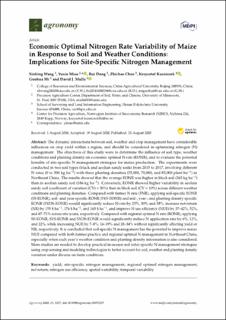| dc.description.abstract | The dynamic interactions between soil, weather and crop management have considerable influences on crop yield within a region, and should be considered in optimizing nitrogen (N) management. The objectives of this study were to determine the influence of soil type, weather conditions and planting density on economic optimal N rate (EONR), and to evaluate the potential benefits of site-specific N management strategies for maize production. The experiments were conducted in two soil types (black and aeolian sandy soils) from 2015 to 2017, involving different N rates (0 to 300 kg ha−1) with three planting densities (55,000, 70,000, and 85,000 plant ha−1) in Northeast China. The results showed that the average EONR was higher in black soil (265 kg ha−1) than in aeolian sandy soil (186 kg ha−1). Conversely, EONR showed higher variability in aeolian sandy soil (coefficient of variation (CV) = 30%) than in black soil (CV = 10%) across different weather conditions and planting densities. Compared with farmer N rate (FNR), applying soil-specific EONR (SS-EONR), soil- and year-specific EONR (SYS-EONR) and soil-, year-, and planting density-specific EONR (SYDS-EONR) would significantly reduce N rate by 25%, 30% and 38%, increase net return (NR) by 155 $ ha−1, 176 $ ha−1, and 163 $ ha−1, and improve N use efficiency (NUE) by 37–42%, 52%, and 67–71% across site-years, respectively. Compared with regional optimal N rate (RONR), applying SS-EONR, SYS-EONR and SYDS-EONR would significantly reduce N application rate by 6%, 12%, and 22%, while increasing NUE by 7–8%, 16–19% and 28–34% without significantly affecting yield or NR, respectively. It is concluded that soil-specific N management has the potential to improve maize NUE compared with both farmer practice and regional optimal N management in Northeast China, especially when each year’s weather condition and planting density information is also considered. More studies are needed to develop practical in-season soil (site)-specific N management strategies using crop sensing and modeling technologies to better account for soil, weather and planting density variation under diverse on-farm conditions. | en_US |

